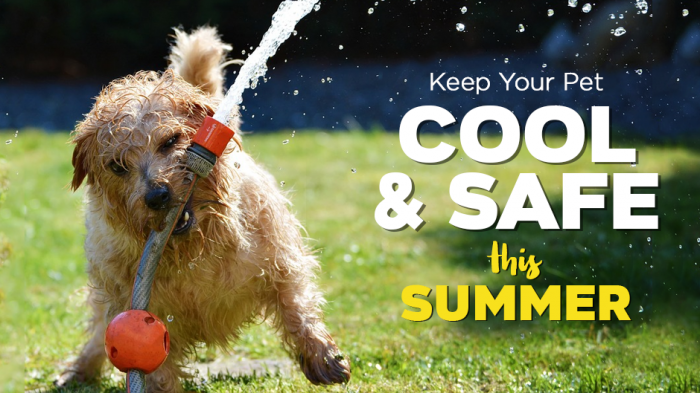Summer is here! Whether you have a hairless Sphynx or a hairy Husky, the heat this time of year can be dangerous for pets. Whatever the breed or size of your kitty or canine, there are a few things to keep in mind when it comes to keeping your pet safe and comfy as the mercury rises.
Dogs and Cats Don’t Sweat
While you may be drenched from head to toe in perspiration, your furry friends release heat and regulate their temperature differently. This means you have to help keep them cool.
How Do Dogs and Cats Keep Cool Without Sweat?
There are some facts you should know about how they regulate their body temperatures.
- If you’ve seen your dog belly flop into your kitchen tile after a midday walk, your dog is using one tactic for body temperature regulation: transferring his or her heat onto a cool surface. This is also a common practice of cats.
- Dogs and cats use convection to cool themselves. How? Pups often do this by wading into cool water or standing right in front of a fan or A/C vent. This pulls heat away from their bodies and into the water or air.
- Panting. Both dogs and cats pant to cool themselves. As their saliva evaporates off their tongues, their body heat lowers.
- Shedding is a longer-term reaction to heat. By letting go of their undercoat, dogs and cats can cool off.
Common Myths About Dogs and Body Heat
- Myth: Shaving your dog will keep them cooler. If your pet has a double or triple coat, always ask if it’s a good idea to shave them. A close shave often results in sunburn more than better heat adaptation.
- Myth: Dogs sweat from their paws to cool themselves. While it’s true dogs do sweat from their paws, this is more often to gain traction and protect their paws than keep their bodies cool. Those pads have too little surface area to truly cool them off. Cooling down is done more so through panting.
- Myth: Cracking the window is enough to keep a pet cool in the car. Temperatures can rise rapidly in a car, even with the windows cracked. It is never a good idea to leave your dog in the car.
What Can You Do to Protect Your Pet from Summer Heat?
There are ways you can help your dog or cat beat the summer heat and stay safe in the sun! Here are some of our top tips for keeping your pet cooler than a cucumber:
- Water, water, everywhere! Make sure your pets have access to cool, fresh water outdoors and indoors. Bring a travel bowl on walks and keep a full bowl wherever your pet may be hanging out. Check outside water dishes and refill them with cool water when the water is warm, try to keep the dish in the shade and don’t use metal bowl for food and water outside – they can get too hot for your dog or cat!
- Change your pet’s walk time to the early morning or evening. This especially applies to highly active play time and walks.
- Don’t let your pet stand on hot asphalt too long and beware of astroturf. Asphalt can be 40 to 60 degrees hotter than the air and astroturf can be 40 to 70 degrees hotter. One rule we suggest is testing the temperature of the surface by placing your hand on it. If it’s too hot for you to hold your hand on for 10 seconds, it’s too hot for your pet to walk on.
- Provide backyard shade. If your pet is going to relax outside, make sure they have some refuge from the sun. An umbrella or patio cover are perfect and make sure they have a cool place to lie down. If you can make a shady area over a spot your dog can dig in, that’s even better. Shade and some cool ground will make your canine companion more comfortable.
- Heatstroke can be fatal and cause permanent damage. Make sure to know the signs of heatstroke and how to respond.
Heatstroke in Dogs and Cats
Dogs and cats experience heat differently than we do. Because their bodies respond to heat differently, they can more rapidly slip into heat exhaustion or heatstroke. These occur when your pets’ body temperatures rises and they cannot release enough heat to cool themselves down to a safe temperature. Heatstroke is always an emergency!
Some common signs of heatstroke include:
- Excessive panting
- Pale or flaring red gums
- A bright red tongue
- Strained breathing
- Lethargy
- Muscle tremors
- Excessive drooling
- Restlessness
- Vomiting
- Diarrhea
- Seizure or falling over
- Lack of urination
- Confusion
- Coma
How to respond if you suspect your pet is experiencing heatstroke:
- Immediately find a cooler environment for your pet.
- Douse your pet in cool (not ice cold) water and place a fan in front of them.
- Call us as quickly as possible. Pets suffering from heatstroke may need IV fluids, and oxygen.
Dogs with brachycephaly (short snouts) have a higher likelihood of heat exhaustion or heatstroke. So, if you have a Pug, Frenchie, Bulldog, or another flat-faced beauty, be very careful when it comes to summer heat.
We hope you have a wonderful summer!
Image credit: Pixabay


